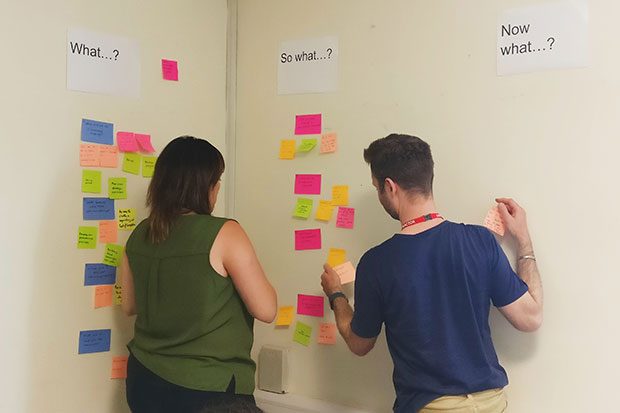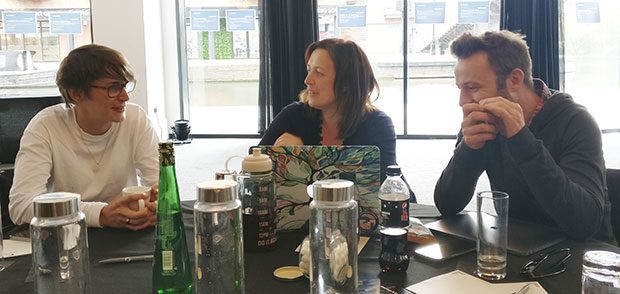 Cathy Dutton reflects on setting up a User Centred Design Community of Practice (COP) for a small team at Defra’s Warrington digital hub.
Cathy Dutton reflects on setting up a User Centred Design Community of Practice (COP) for a small team at Defra’s Warrington digital hub.
How do you build a community with small numbers of people in different roles with various work patterns?
At our Warrington digital hub there are currently 3 Interaction Designers, 4 User Researchers and one Content Designer. And until recently there was no local Community of Practice (COP) in any of these areas.
Why not? Barriers to setting up the community
There can be a lot of barriers to running a successful COP with a small team.
People
A successful community needs people in the same place who are able to have face to face discussions, share ideas and show work. In smaller digital hubs or remote locations this can be difficult to achieve.
Time
Project work is the priority and can be all consuming for people working in small agile teams.
Locations
Although we share the same base location, research and design roles often take people out and about on research trips, conferences and cross government meet-ups. There's also working from home days and people’s differing core hours to consider.
Pressure
In small communities there can be a sense of pressure to attend and contribute. Either to organise and run the community or to deliver presentations or workshops. There can also be pressure from outside the community to deliver ‘something’ to justify the time away from projects.
Topics
Communities could become alienating for some people. Particularly if they don’t relate to the chosen topics of discussion or are unable to influence or input into the decisions.

Removing these barriers
To kick off the new community we tried to remove some of these barriers.
Be open and inclusive
Firstly we opened the community to everyone working in User Centred Design roles:
- User Researchers
- Interaction Designers
- Content Designers
- Service Designers
More people equates to better, more varied discussions and ideas.
Empower everybody
We collectively decided on what the COP should be for, what day we should meet and what our aims should be. We included everybody in this discussion - to make sure we accommodated each individual’s working patterns and project days.
Keep it casual
We decided to run the community without an agenda. The hope is that this will remove the pressure to have ‘done something’ or prepare a pre-set topic. Keeping sessions conversational ensures each member has a voice and an opportunity to suggest a discussion. It also makes it easier to adapt sessions based on the attendees.
Keep it frequent
We decided on a Tuesday slot at 1pm on alternating weeks, to align to each team’s sprint planning and retro days. Having a meeting every 2 weeks means there are plenty of opportunities to share work without a build-up developing. It also means that if you miss a meeting there's another one just around the corner.
Have guidelines
Finally we borrowed some community guidelines from a cross-government design system meet up run by the GOV.UK design system team.
That it’s ok to:
- not be available
- have the meet up without everybody present
- catch up on things you missed outside of the designated community hour
- have nothing to update or input
Future plans for the community
Right now we are finding common goals and areas of interest to look into. But as the community grows, it may become more difficult to continually generate discussion ideas on the fly.
When this happens we plan to use the findings of other larger COP and move towards a more objective-based approach. We also plan to trial a weekly meet up and experiment with assigning community roles.
We’ll keep you updated on our progress.
Find out more about Communities of Practice at Defra

4 comments
Comment by Imran Hussain posted on
Thanks for this blog Cathy, it's a really interesting insight into how you dealt with the problems that everyone faces with starting a community.
Look forward to hearing more about your community in the future.
Comment by Ian McLoughlin posted on
Great article Cathy, thanks for writing it; it has definitely opened my eyes to this new area of activity.
Going back to fundamentals, what is a design community? I am based in Warrington and have never heard of it / one. Going slightly off topic here, sorry, but would we like more people, particularly operational / frontline people to engage with these communities? If so, I think we need to reconsider the language and be clear on the value said community will bring to their work.
I was interested to note that there isn't any reference to accountability of the community to ensure they are adding value to the organisation and aligning their work to organisational priorities.
It would be great if we could raise the profile of these communities by sharing the outcomes they've achieved, eg in Environment Agency Weekly Buzzes, This Week In Defra, Environment Agency Cascades, Intranet articles etc.
All the best,
Ian
Defra Group Continuous Improvement Team
Comment by Imran Hussain posted on
Hi Ian, I’m the Community of Practice Manager at Defra Digital. Communities were started in our Digital Directorate and are essentially groups of people in the same role, who share best practice, mentor each other and work on their self-development.
You can read a little bit more about them around their time of inception in 2017 here:
https://defradigital.blog.gov.uk/2017/09/29/take-time-to-take-part-in-communities-of-practice/
Communities align to Defra’s Target Operating Model, Single Department Plan and Defra’s 5 ‘Principles That Inform How We Act’ because they are focused on developing professional expertise for our staff; increase co-ordination and knowledge-sharing between several Defra Group bodies; promote inclusivity and respect for peers; provide support networks for community members; align with and promote Defra Digital’s learning strategies (and learning platforms); and encourage innovation within roles.
All the literature indicates that community of practice members need to have autonomy in deciding their own areas of focus in order to provide value for its members. The power of one of these communities is to harness the collective passion, enthusiasm and areas of interest of community members and achieving something as a collective. At Defra we see them as a ‘safe space’ for our colleagues to experiment, try new things and use some of their allotted self-development time. We’ve found it leads to happier, more engaged, enthusiastic staff.
We’ve started talking to other areas outside Digital about starting communities of practice, happy to have a conversation with you about how this might benefit operational areas. Communities are all about the continuous improvement of expertise within our organisation, after all.
Regards,
Imran Hussain
Comment by Ian McLoughlin posted on
Thanks for your comprehensive response Imran.
It appears I was a little confused on what a design community is, so thank you for helping me understand.
And yes, I would love to talk sometime about the expansion into non-digital functions, feel free to call anytime.